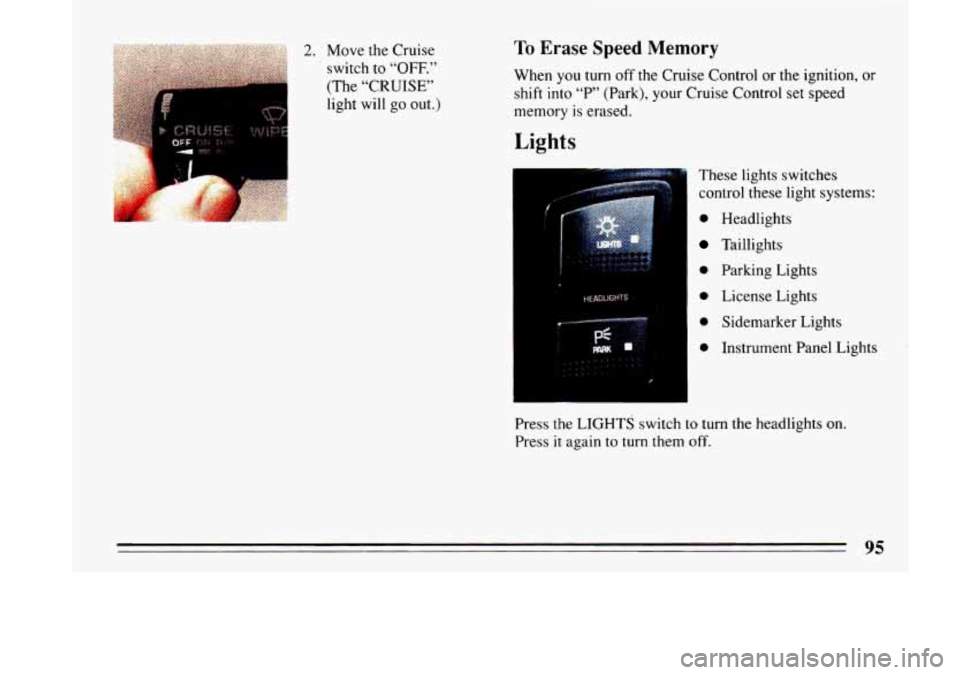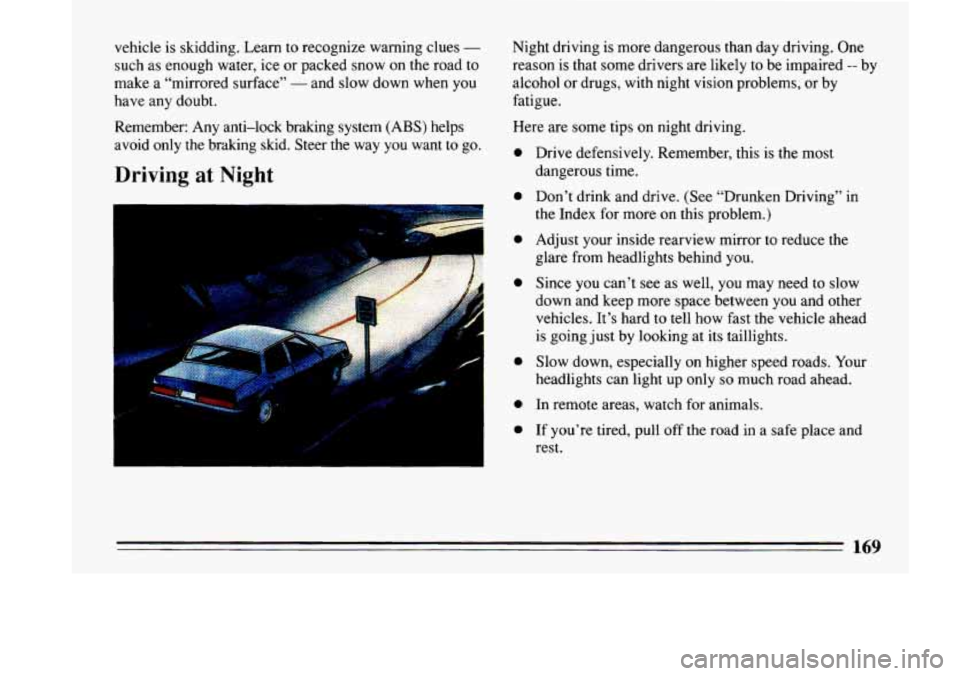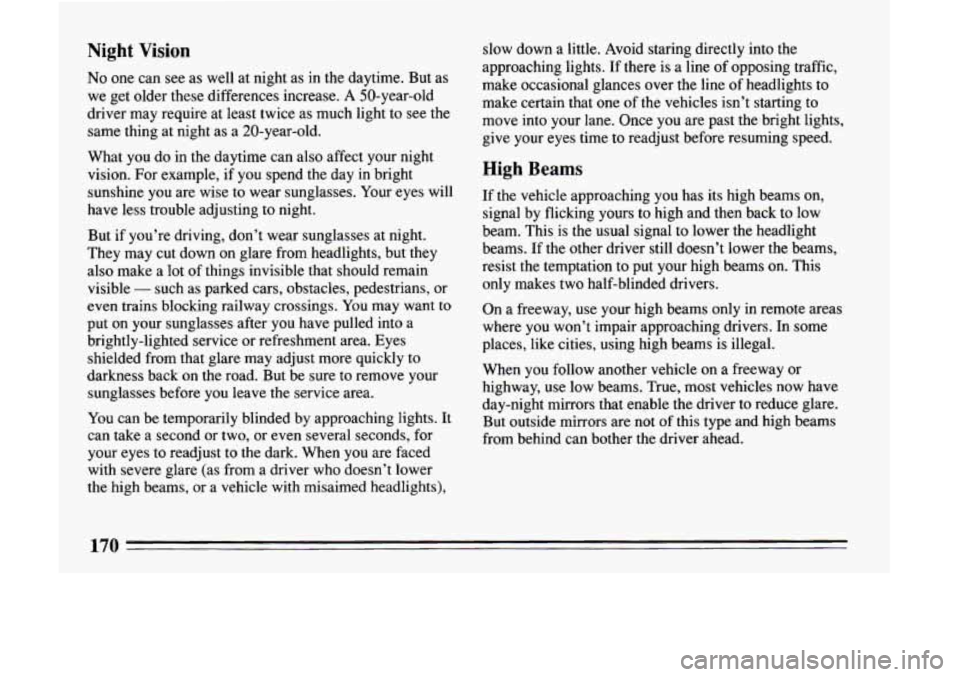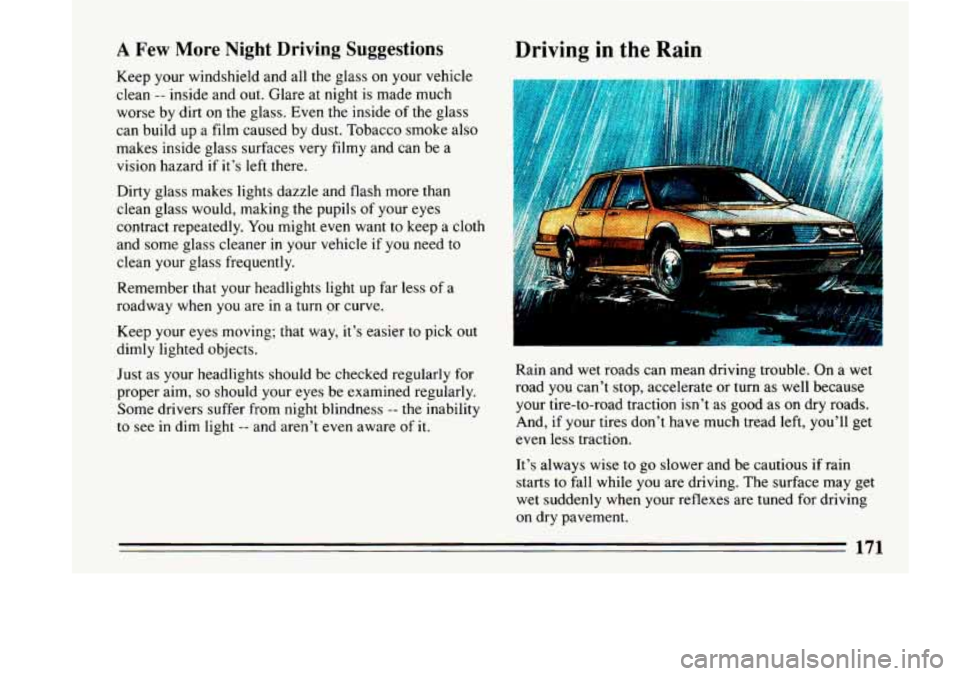1993 BUICK LESABRE headlights
[x] Cancel search: headlightsPage 89 of 324

some jurisdictions may require that you operate your
lower beam lamps with fog lamps at all times, or that
headlamps be turned on whenever you must
use your
windshield wipers.
In addition, most jurisdictions
prohibit driving solely with parking lamps, especially at
dawn or dusk. It
is recommended that you check with
you own State or Provincial highway authority for
applicable lighting regulations.
Headlight High-Low Beam
’ To change the headlights
from low beam to high or
high to low, pull the turn
signal lever all the way
toward you. Then release it.
When the high beams are
on, this blue light on the
instrument panel also will
be on.
Windshield Wipers
... ,rll
You control the windshield wipers by turning the band
marked “WIPER.”
For a single wiping cycle, turn the band to “MIST.”
Hold it there
until the wipers start, then let go. The
wipers will stop after one cycle. If you want more
cycles, hold the band
on “MIST” longer.
You can set the wiper speed for a long
or short delay
between wipes. This can be very
useful in light rain or
snow. Turn the band
to choose the delay time. The
closer to
“LO,” the shorter the delay.
87
Page 97 of 324

2. Move the Cruise switch to
“OFF.”
(The “CRUISE’
light will go out.)
To Erase Speed Memory
When you turn off the Cruise Control or the ignition, or
shift
into “P” (Park), your Cruise Control set speed
memory
is erased.
Lights
. .
i
~
i
These lights switches
control these light systems:
0 Headlights
Taillights
~ HEADLIGHTS
0 Parking Lights
0 License Lights
0 Sidemarker Lights
0 Instrument Panel Lights
Press the LIGHTS switch
to turn the headlights on.
Press
it again to turn them off.
ac
Page 100 of 324

Daytime Running Lights (Canada Only)
The Canadian Federal Government has decided that
“Daytime Running Lights” (DRL) are a
useful feature,
in that DRL can make your vehicle more visible to
pedestrians and other drivers during daylight hours.
DRL are required on new vehicles sold in Canada.
Your DRL work with
a light sensor on top of the
instrument panel. Don’t cover it up.
The low beam headlights will come on at reduced
brightness in daylight when:
The ignition is on
The headlight switch is off, and
The transaxle is not in “P” (Park).
At dusk, the exterior lights will come
on automatically
and the low beams will change
to full brightness. At
dawn, the exterior lights will go out and the low beams
will change
to the reduced brightness of DRL (if the
headlight switch is
off).
Of course, you may still turn on the headlights any time
you need to.
To idle your vehicle with the DRL off, shift the
transaxle into
“P” (Park). The DRL will stay off until
you
shift out of “P” (Park).
To turn off all exterior lighting at night when
you are
parked, move the twilight sentinel control from
ON to
OFF, if it was on from the start. Or, move the control
from
OFF to ON, then back to OFF, if it was off from
the start. The lights will come back
on when you move
the transaxle
out of PARK.
Page 171 of 324

vehicle is skidding. Learn to recognize warning clues -
such as enough water, ice or packed snow on the road to
make a “mirrored surface”
- and slow down when you
have any doubt.
Remember: Any anti-lock braking system (ABS) helps
avoid only the braking skid. Steer the way
you want to go.
Driving at Night
Night driving is more dangerous than day driving. One
reason is that some drivers are likely
to be impaired -- by
alcohol or drugs, with night vision problems, or by
fatigue.
Here are some tips on night driving.
0
0
0
0
0
0
0
Drive defensively. Remember, this is the most
dangerous time.
Don’t drink and drive, (See “Drunken Driving’’ in
the Index for more
on this problem.)
Adjust your inside rearview mirror to reduce the
glare from headlights behind you.
Since you can’t see as well,
you may need to slow
down and keep more space between you and other
vehicles. It’s hard to tell
how fast the vehicle ahead
is going just by looking at its taillights.
Slow down, especially on higher speed roads. Your
headlights can light up only
so much road ahead.
In remote areas, watch for animals.
If you’re tired, pull off the road in a safe place and
rest.
169
Page 172 of 324

Night Vision
No one can see as well at night as in the daytime. But as
we get older these differences increase.
A SO-year-old
driver may require at least twice as much light to see the
same thing at night as a 20-year-old.
What you do in the daytime can also affect your night
vision. For example, if you spend the day
in bright
sunshine you are wise to wear sunglasses. Your eyes will
have less trouble adjusting to night.
But if you’re driving, don’t wear sunglasses at night.
They may cut down on glare from headlights, but
they
also make a lot of things invisible that should remain
visible
- such as parked cars, obstacles, pedestrians, or
even trains blocking railway crossings. You may want to
put on your sunglasses after you have pulled into
a
brightly-lighted service or refreshment area. Eyes shielded from that glare may adjust more quickly to
darkness back on the road. But be sure to remove your sunglasses before you leave the service area.
You can be temporarily blinded by approaching lights. It
can take a second
or two, or even several seconds, for
your eyes to readjust to the dark. When you are faced
with severe glare (as from
a driver who doesn’t lower
the high beams, or a vehicle with misaimed headlights), slow down
a little. Avoid staring directly into the
approaching lights. If there is a line of opposing traffic,
make occasional glances over the line of headlights to
make certain that one of the vehicles isn’t starting to
move into your lane. Once you are past the bright lights,
give your eyes time to readjust before resuming speed.
High Beams
If the vehicle approaching you has its high beams on,
signal by flicking yours to high and then back
to low
beam. This is the usual signal to lower the headlight
beams. If the other driver still doesn’t lower the beams,
resist the temptation to put your high beams on. This only makes two half-blinded drivers.
On a freeway, use your high beams only in remote areas
where you won’t impair approaching drivers. In some
places, like cities, using high beams is illegal.
When you follow another vehicle on a freeway or
highway, use low beams. True, most vehicles now have day-night mirrors that enable the driver to reduce glare. But outside mirrors are not of this type and high beams
from behind can bother the driver ahead.
170
-
Page 173 of 324

A Few More Night Driving Suggestions
Keep your windshield and all the glass on your vehicle
clean
-- inside and out. Glare at night is made much
worse by dirt on the glass. Even the inside
of the glass
can build up a film caused by dust. Tobacco smoke also
makes inside glass surfaces very filmy and can be a
vision hazard if it’s left there.
Dirty glass makes lights dazzle and flash more than
clean glass would, making the pupils
of your eyes
contract repeatedly. You might even want
to keep a cloth
and some glass cleaner in your vehicle if
you need to
clean your glass frequently.
Remember that your headlights light up far less
of a
roadway when you are in a turn
or curve.
Keep your eyes moving; that way, it’s easier to pick out
dimly lighted objects.
Just
as your headlights should be checked regularly for
proper aim,
so should your eyes be examined regularly.
Some drivers suffer from night blindness
-- the inability
to see in dim light -- and aren’t even aware of it.
Driving in the Rain
/’ ..
Rain and wet roads can mean driving trouble. On a wet
road you can’t stop, accelerate or turn as well because
your tire-to-road traction isn’t as good
as on dry roads.
And, if your tires don’t have much tread left, you’ll get
even less traction.
It’s always wise to go slower and be cautious if rain
starts to fall while you are driving. The surface may get
wet suddenly when your reflexes are tuned for driving
on dry pavement.
171
Page 175 of 324

to pass -- or if you get hit by a gust of wind. You could
suddenly find yourself out of control.
Hydroplaning doesn’t happen often. But it can
ir your
tires haven’t much tread or if the pressure in one or
more is low.
It can happen if a lot of water is standing
on the road. If you can see reflections from trees,
telephone poles, or other vehicles, and raindrops
“dimple” the water’s surface, there could be
hydroplaning.
Hydroplaning usually happens at higher speeds. There
just isn’t a hard and fast rule about hydroplaning. The
best advice is to slow down.when it is raining, and be
careful.
Some Other Rainy Weather Tips
0 Turn on your headlights -- not just your parking
lights
-- to help make you more visible to others.
0 Look for hard-to-see vehicles coming from behind.
You may want to use your headlights even
in
daytime if it’s raining hard.
0 Besides slowing down, allow some extra following
distance. And be especially careful when you pass
another vehicle. Allow yourself more clear room
ahead, and be prepared to have your view restricted
bv road spray. If the road spray is so heavy you are actually blinded,
drop back. Don’t pass until
conditions improve. Going more slowly is better
than having an accident.
0 Use your defogger if it helps.
0 Have good tires with proper tread depth. (See
“Tires” in the Index.)
Driving in Fog, Mist and Haze
Page 176 of 324

Fog can occur with high humidity or heavy frost. It can
be so mild that you can see through it for several
hundred feet (meters). Or it might be
so thick that you
can see only a few feet (meters) ahead. It may come
suddenly to an otherwise clear road. And it can be a
major hazard.
When
you drive into a fog patch, your visibility will be
reduced quickly. The biggest dangers are striking the
vehicle ahead or being struck by the one behind. Try to
“read” the fog density down the road. If the vehicle
ahead starts to become less clear or, at night, if the
taillights are harder to see, the fog is probably
thickening. Slow down to give traffic behind you a
chance to slow down. Everybody then has a better
chance to avoid hitting the vehicle ahead.
A patch of dense fog may extend only for a few feet
(meters) or for miles (kilometers); you can’t really tell
while you’re in
it. You can only treat the situation with
extreme care.
One common fog condition
-- sometimes called mist or
ground fog
-- can happen in weather that seems perfect,
especially at night or in the early morning in valley and
low, marshy areas. You can be suddenly enveloped in
thick, wet haze that may even coat your windshield.
You
can often spot these fog patches or mist layers with your
headlights. But sometimes they can be waiting for
you
as you come over a hill or dip into a shallow valley.
Start your windshield wipers and washer, to help clear
accumulated road dirt. Slow down carefully.
Tips on Driving in Fog
If you get caught in fog, turn your headlights on low
beam, even in daytime. You’ll see
-- and be seen --
better.
Don’t use your high beams. The light will bounce
off the
water droplets that make up fog and reflect back at you.
Use your defogger. In high humidity, even a light
buildup of moisture
on the inside of the glass will cut
down on your already limited visibility. Run your
windshield wipers and washer occasionally. Moisture
can build up on the outside glass, and what seems
to be
fog may actually be moisture on the outside of your
windshield.
Treat dense fog as an emergency. Try to find a place
to
pull off the road. Of course you want to respect
another’s property, but you might need to put something
between
you and moving vehicles -- space, trees,
telephone poles, a private driveway, anything that
removes you from other traffic.
If visibility is near zero and you must stop but are
unsure whether you are away from the road, turn your